NR 507
South University
All 8 results
Sort by
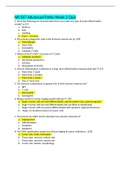
-
NR 507 Advanced Patho Week 2 Quiz
- Exam (elaborations) • 3 pages • 2023
-
- $7.00
- + learn more
NR 507 Advanced Patho Week 2 QuizAll of the following are characteristics that occur with any type of acute inflammation except? p.214 a. Redness b. Pain c. Swelling d. Fever – mccance 2. The primary phagocytic cells in the immune systems are (p. 199) a. Macrophages b. Mast Cells c. Eosinophils d. Cytotoxic T-Cells 3. Which of the ff is NOT a function of T- Cells? a. Antibody synthesis * b. Interleukin production c. Cell lysis d. Stimulation of B-cells 4. Chronic inflammation ...
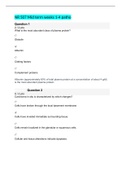
-
NR 507 Mid term weeks 1-4 patho
- Exam (elaborations) • 33 pages • 2023
-
- $16.00
- + learn more
NR 507 Mid term weeks 1-4 What is the most abundant class of plasma protein? Globulin Albumin Clotting factors Complement proteins Albumin (approximately 60% of total plasma protein at a concentration of about 4 g/dl) is the most abundant plasma protein. IncorrectQuestion 2 0 / 2 pts Carcinoma in situ is characterized by which changes? Cells have broken through the local basement membrane. Cells have invaded immediate surrounding tissue. ...

-
NR 507 Week 7: Notes
- Exam (elaborations) • 5 pages • 2023
-
- $5.00
- + learn more
NR 507 Week 7: NotesNeurological Alterations: Disorders of the neurologic system are typically categorized into either central nervous system (CNS) disorders or peripheral nervous system (PNS) disorders. The CNS includes the brain and spinal cord and the PNS includes all of the other nervous tissue within the body. A functioning CNS is required in order for an individual to experience awareness or consciousness: however, there are various levels of consciousness and various disorders that impac...
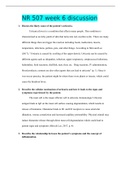
-
NR 507 week 6 discussion
- Exam (elaborations) • 3 pages • 2023
-
- $7.00
- + learn more
NR 507 week 6 discussion1. Discuss the likely cause of the patient’s urticaria. Urticaria (hives) is a condition that affects many people. This condition is characterized as an itchy patch of skin that turns into red, swollen welts. There are many different things that can trigger the reaction including foods, medication, insects, temperature, infections, pollens, pets, and other things. According to Shin and Lee (2017), "Urticaria is caused by swelling of the upper dermis. Urticaria can b...

-
NR 507 Week 6 Quiz.| LATEST SOLUTION
- Exam (elaborations) • 10 pages • 2023
-
- $12.00
- + learn more
NR 507 Week 6 Quiz.1. Question : A(n) _____ fracture is a fracture at a site of a preexisting bone abnormality, usually by a force that would not normally cause a fracture. Student Answer: idiopathic incomplete pathologic greenstick Instructor Explanation: A pathologic fracture is a break at the site of a preexisting abnormality, usually by force that would not fracture a normal bone. Points Received: 2 of 2 Comments: Question 2. Questio...
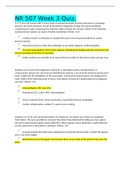
-
NR 507 Week 3 Quiz.| 100% CORRECT ANSWERS
- Exam (elaborations) • 17 pages • 2023
-
- $14.00
- + learn more
NR 507 Week 3 Quiz.NR 507 Week 3 Quiz. 1. A 72-year-old woman with a recent onset of syncopal episodes has been referred to a cardiology group by her family physician. As part of the patient's diagnostic workup, the nurse practitioner conducting the intake assessment has ordered a Holter monitor for 24 hours. Which of the following statements best captures an aspect of Holter monitoring? (Points : 0.4) A Holter monitor is preferable to standard ECG due to its increased sensitivity to ...
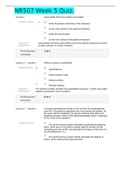
-
NR 507 Week 5 Quiz.| VERIFIED GUIDE
- Exam (elaborations) • 10 pages • 2023
-
- $13.00
- + learn more
NR507 Week 5 Quiz.Question : Lipid-soluble hormone receptors are located Student Answer: inside the plasma membrane in the cytoplasm. on the outer surface of the plasma membrane. inside the mitochondria. on the inner surface of the plasma membrane. Instructor Explanation: Lipid-soluble hormones easily diffuse across the plasma membrane and bind to either cytosolic or nuclear receptors. Points Received: 2 of 2 Comments: Question 2. Questi...

Study stress? For sellers on Stuvia, these are actually golden times. KA-CHING! Earn from your study resources too and start uploading now. Discover all about earning on Stuvia


